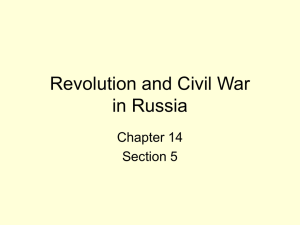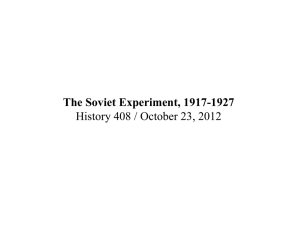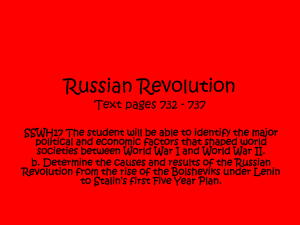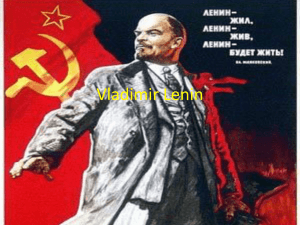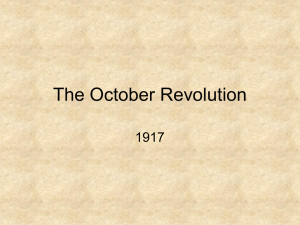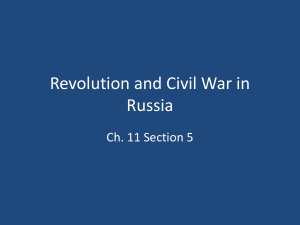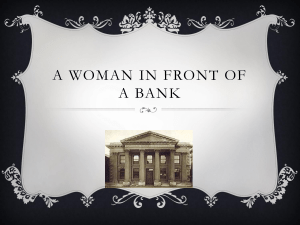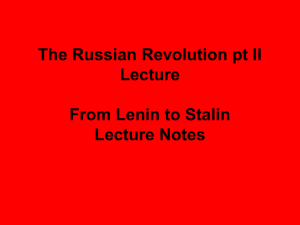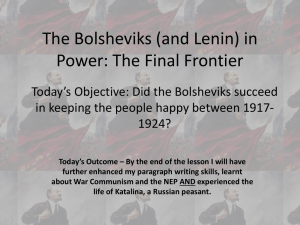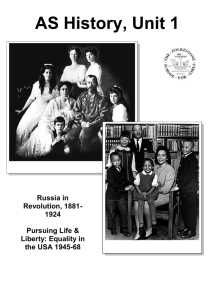LENINS POLICIES FROM 1918
advertisement
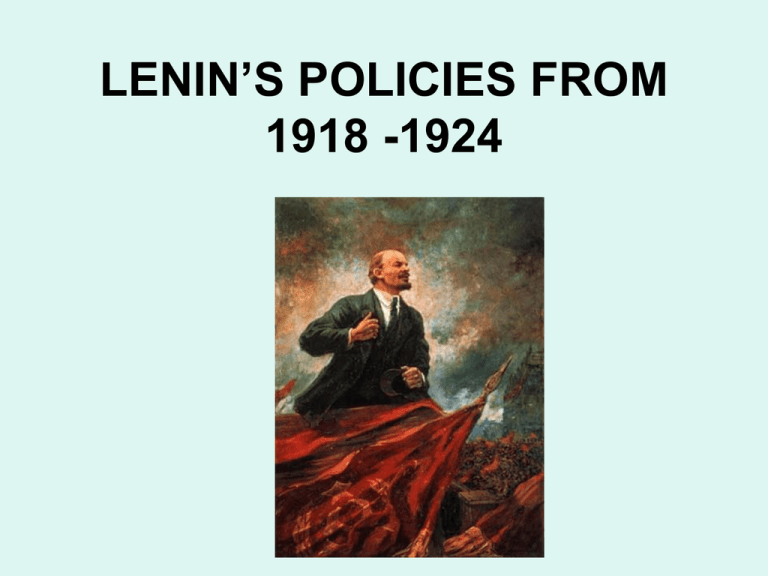
LENIN’S POLICIES FROM 1918 -1924 Origins of the Civil War Takeover of Lenin and the decrees Led to depopulation of the cities, Widespread famine and a drop in living standards Fear of workers’ revolutions spreading to Europe Political opposition to Communism The Bolsheviks controlled the heartland of Russia and faced attacks on all sides. The capital was moved to Moscow and key Bolsheviks surrounded themselves with bodyguards. M Conservative Generals led the White Armies in attacks and battles against the Red Army. • The Ukraine, the Poles and Cossacks wanted independence. • Britain, France, Japan and Czechoslovakia supported the Whites. • The Red Armies faced a crisis and Lenin and Trotsky were forced to introduce harsh policies to keep the revolutionary army supplied. • The White Armies also requisitioned supplies. Trotsky and the Red Army Trotsky formed the Red Army from conscripts, Bolsheviks and antitsarist soldiers. To horse, Proletarian! This Civil war poster by Victor Deni depicts Trotsky as Saint George slaying the counter-revolutionary dragon. Using Christian imagery and mythology to present a revolutionary message was common in the Soviet propaganda. http://www.fbuch.com/posters.htm WAR COMMUNISM • • • • • • • Forced requisitioning of agricultural produce Strict price controls on agricultural produce State monopoly on grain purchases Near nationalisation of manufacturing industries Nationalisation of retailing Forced labour for civilians and soldiers Money based trade replaced by barter due to hyperinflation. Money became worthless. Food supply crisis • WHY? Poor infrastructure and transport White Terror Peasant resistance Disruption caused by WWI and the Civil War. Kulak resistance Red Terror Bolshevik propaganda posters "The workers and the peasants are finishing off the Polish gentry and the barons, but the workers on the home front also have not forgotten about help to the peasant economy. Long live the union of the workers and peasants!" At the bottom: "Week of the Peasant." (From N. I. Baburina, ed., The Soviet Political Poster, 19171980, from the USSR Lenin Library Collection [Harmondsworth: Penguin, 1985], plate 18.) "Without a saw, axe, or nails you cannot build a home. These tools are made by the worker, and he has to be fed.“ (From N. I. Baburina, ed., The Soviet Political Poster, 19171980, from the USSR Lenin Library Collection [Harmondsworth: Penguin, 1985], plate 21.) Propaganda used by the White Army This poster depicts Trotsky as a ‘red skinned demon like caricature’ in this poster. The depiction attempts to appeal to anti-Semitism and Chinese soldiers (below, wearing braids and blue and gold uniforms). The Bread War • The Bolsheviks waged a civil war against the peasants for grain. • Hoarding and black markets arose • The Cheka and Food Patrols terrorised peasants. Shortages became more widespread. LENIN: "Merciless war against the kulaks! Death to them." • Lenin in reality despised the peasantry as ‘petty bourgeoisie’ who were against forced collectivisation of land. • He favoured the interests of the working class although trade unions and strikes in the cities and towns were also banned. • The Bolsheviks began a ‘class war’ against the ‘enemies of the State’ while the war raged against the ‘capitalist invaders’. The Red Terror • Brutality increased as uncooperative peasants refused to hand over all their grain. • Grain had to be sold to the State at fixed prices. • Resisting peasants were branded ‘kulaks’ and were targeted. Zinoviev 1918 • “We are very well aware that we cannot carry through the proletarian revolution without crushing the village kulaks and without annihilating them psychologically and, if necessary, physically. . . . The revolution in the village should take the kulak by the throat and strangle him according to all the rules of soviet art; it is precisely for this that we need a genuine, operative worker-peasant machine for strangling kulaks." www.gmu.edu Consequences PRODUCTION OF GRAIN 1913 80 MILLION TONS 1921 37.6 MILLION TONS INDUSTRIAL OUTPUT (millions of tons) 1913 Victims of famine in the Volga region, 1921. 29 MILLION RUSSIANS EXPERIENCED FAMINE. 5 MILLION DIED Coal 29 1921 9 Oil 9.2 3.8 Iron 4.2 0.1 Steel 4.3 0.2 Sugar 1.3 0.05 Elec (in million kWh) 2039 520 Concentration camps – The Gulag • “In April 1919, following Dzerzhinsky’s recommendation and with Lenin’s approval, the Soviet government ordered the establishment of a network of concentration camps, at least one per province, the first of its kind in history, which served as a model and inspiration to Hitler and his Nazis and was later to become infamous as the GULAG. By 1923 the number of these camps had reached 315.” (Warren H. Carroll, The Rise and Fall of the Communist Revolution, p. 142) Alexander Solzhenitsyn wrote The Gulag Archipelago about his experiences.. A man who froze to death THE KRONSTADT REBELLION 1921 THE FIRST OPEN REBELLION AGAINST THE COMMUNIST REGIME. The fortress and naval base at Kronstadt Alarm bells for the Communists! • Kronstadt sailors sympathised with the striking workers and the victims of War Communism. • Drew up a 15 point petition including free elections to the soviets and freedom of the press. • Held a mass meeting of 15 000 people to discuss frustrations with Lenin’s regime. Course of events • Elected a committee to lead rebellion. • Adopted the 1917 slogan “All power to the soviets- not to parties.” • Word got out of a “Third Revolution” • Lenin issued an ultimatum but the rebels continued with a peaceful revolt. • The Bolsheviks attacked the fortress and after 10 days the revolt was crushed. • • • • 10 000 of Lenin’s troops died 4 000 rebels deported to labour camps 74 leaders publicly shot 8 000 soldiers, sailors and people escaped to Finland. • Families of the rebels either killed or deported to Siberia. Call in the Red Army, the Cheka and Trotsky. • The sea was frozen and the Red Army attacked with machine guns ready. • The Cheka kept back and shot any soldiers who refused to attack. THREAT OF COUNTER-REVOLUTION AND ECONOMIC COLLAPSE MADE LENIN INTRODUCE THE NEW ECONOMIC POLICY TO SAVE THE REVOLUTION. The New Economic Policy 19211924 • - An economic policy that was: pragmatic market-related recovery measure compromise with some capitalistic measures - intended to be an interim measure - NOT aimed at abandoning Communism. Measures • Limited private ownership in agriculture and industry – surpluses could be sold for profit. A grain tax was introduced. • Small industries could employ up to 20 workers but NEPMEN lost their right to vote. • Kulaks could hire labour and lease land. • Agricultural production increased Encourage agricultural production by abolishing food requisitioning and price controls. Surpluses could be sold on the open market. Create an interdependence between the countryside and the urban areas. The Communists still controlled the commanding heights of the economy – banking, shipping, large industrial plants and foreign trade. Collectivisation was relaxed. "From the NEP Russia will come the socialist Russia." An assessment of the NEP POSITIVE NEGATIVE 1924-1928 economic growth Unemployment not solved More stability experienced Prices still too high for peasants Electrification of Russia Classes were reintroduced Some peasants e.g. kulaks became wealthy Many peasants still farmed with backward equipment. Class distinction led to Many people were angry discrimination and a lack about personal gain of of unity. Nepmen and Kulaks. By 1926 economy had reached pre-WW I levels. Food supply still a problem; methods not socialistic enough. Lenin’s death Lenin suffered four strokes and died in 1924. His brain was removed to study the origins of his ‘genius’. His body was embalmed and placed on permanent exhibition in the Lenin Mausoleum in Moscow. Petrograd was renamed Leningrad in his honour. Despite requesting no memorials or statues in his honour, many were erected to honour him.

